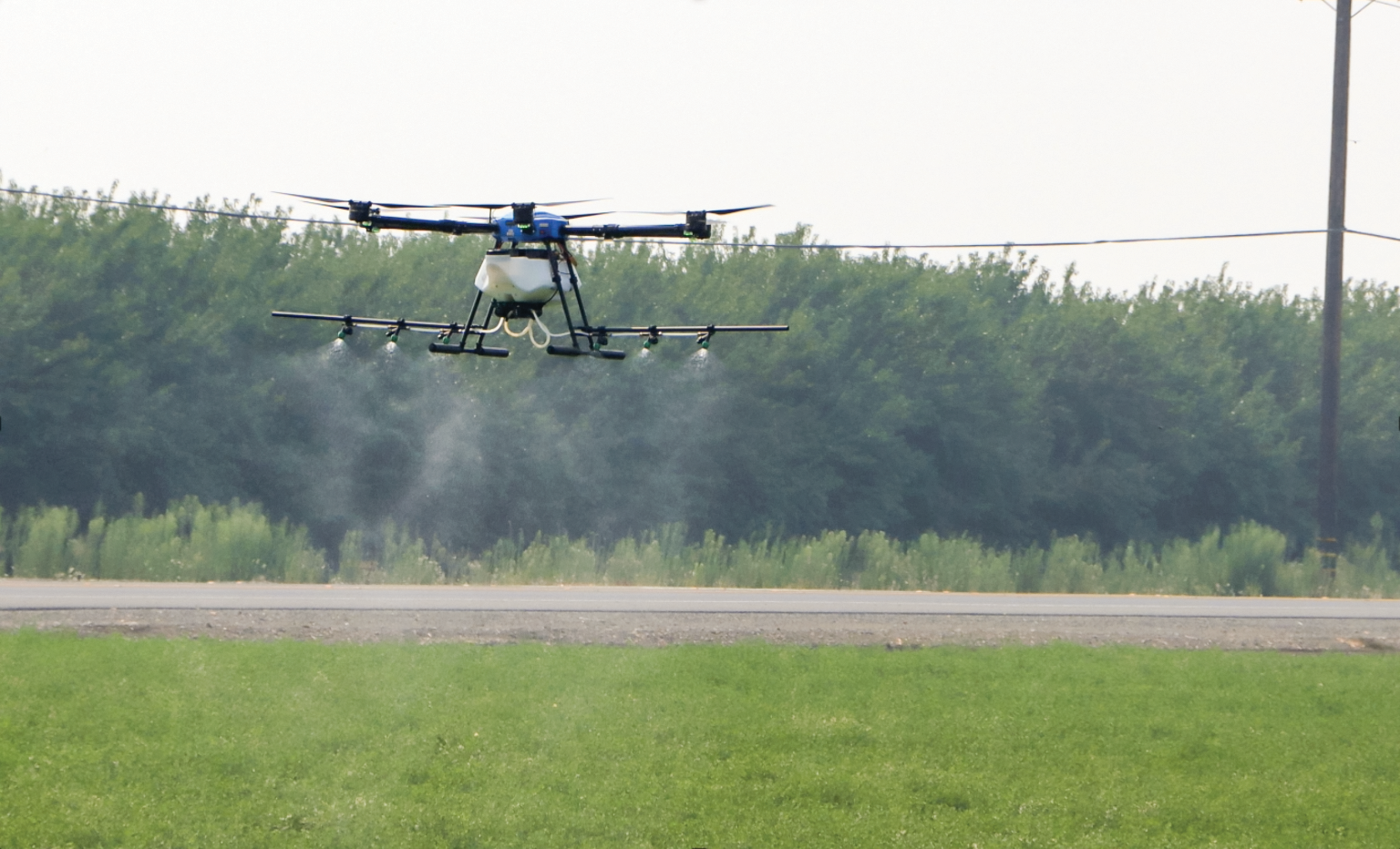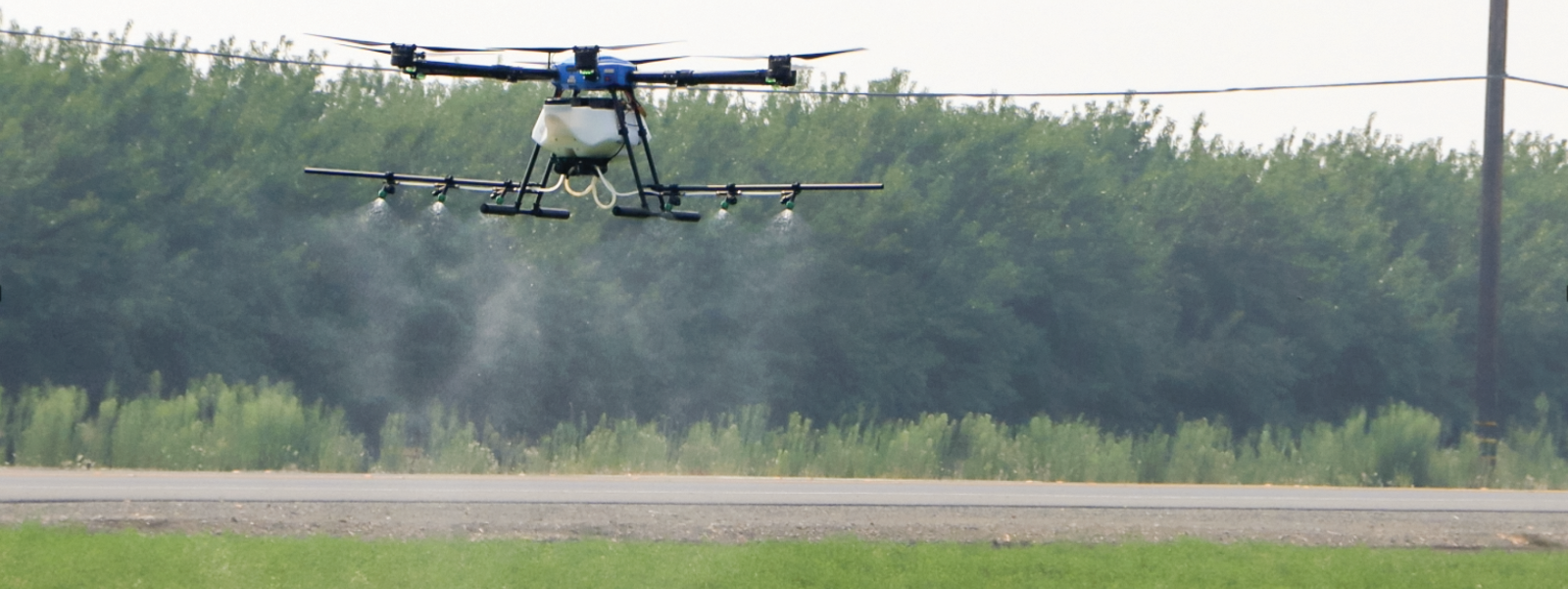Studies tout precise pesticide applications, drones

A drone applies pesticides to an alfalfa field in Yolo County during trials conducted by University of California researchers in 2020. Proposed legislation could help facilitate drone use on farm fields.
Photo/University of California Agriculture and Natural Resources

By Bob Johnson
Future farmers may benefit from insect control systems that are more precise, efficient and safe than today’s pesticide applications. The use of drones, in particular, could make for uniform and precise applications, while allowing farm employees to maintain distance from spraying.
Drones are already increasingly used to release beneficial insects in farm fields. For example, Braga Fresh, a producer of organic and conventional vegetables and salads, is using the technology—and a licensed drone operator—to administer pest-devouring bugs at its organic ranch in Soledad.
University of California and U.S. Department of Agriculture trials showed that precision pesticide application provided superior control of aphids, thrips and a deadly plant virus that thrips have carried to lettuce in the Central Coast. Though the studies analyzed camera-based systems mounted on tractors, researchers say the technology is similar to that used in drone spraying.
In 2020, UC researchers evaluating the efficiency of drones applying insecticides in alfalfa fields in Yolo County concluded the technology offered “a viable option for aerial application of pesticides.”
“Many California farmers want the opportunity to utilize this safe and accurate technology,” said Al Stehly, a third-generation farmer who grows avocados, citrus fruit and winegrapes in San Diego County and runs a custom applicator business.
Stehly said the technology offers an aerial application tool for farmers in situations in which helicopters or fixed-wing aircraft are neither efficient nor cost-effective. He said drones offer effective remedies for small vineyards and farms as well as targeted treatments for larger properties.
Stehly testified before the state Assembly Committee on Agriculture on March 29 on behalf of legislation to adopt more flexible licensing requirements for farmers who want to use drones to apply insecticides and fungicides. Sponsored by the California Farm Bureau and introduced by Assembly Member Reggie Jones-Sawyer, D-Los Angeles, the bill has advanced to the Assembly Appropriations Committee with bipartisan support.
Current regulations require farmers to complete a time-consuming apprenticeship program before they can be licensed to use drones for pesticide applications.
Stehly said AB 1016 would give the California Department of Pesticide Regulation “direction and flexibility to craft a clearer path for farmers like me to get licensed without compromising the safety of field workers or the public.”
The current standard method for applying insecticides is to have a rig broadcast the material to seed lines as it travels between crop rows or have workers apply insecticides from backpacks.
Stehly said using drones can eliminate the need for a mist blower—“basically a leaf blower with a tank of chemicals, weighing about 60 pounds, fully loaded, that is carried on the back of the field worker.” He added, “The field worker trudges through the vineyard, trying to maintain a uniform walking speed and application rate while climbing up and down hills, avoiding rocks and gopher holes.
“With drone spray technology, we can not only remove the worker from the application area, we’re removing a heavy, gas-filled sprayer and chemical-filled tank from their back.”
Researchers are focusing on multiple tools for precise pesticide applications. UC Cooperative Extension entomology specialist Ian Grettenberger and USDA entomologist Daniel Hasegawa supervised trials using the same camera-based system as auto weeder-thinners widely used in California and Arizona lettuce production.
Cameras mounted on tractors identified plant doubles and weeds in seed lines, and a spray rig eliminated them by precisely applying herbicide on unwanted plants.
Although Hasegawa and Grettenberger used weeder-thinner tractor rigs in which cameras distinguish the crop from plants to be removed, cameras are already used on drones to map vegetation and vigor differences within large fields and vineyards.
Grettenberger and Hasegawa reported promising results from their trials during the California Leafy Greens Research Board’s annual research conference in March. They said the camera-based precision applications of four organic insecticides were all significantly superior to broadcast applications in knocking down thrips populations.
The improved thrips control with the more precise application cut the rate of deadly impatiens necrotic spot virus in half or more, they said. Managing the pests is particularly important in the Salinas Valley, where thrips have spread the deadly virus in recent years, causing widespread damage to lettuce crops.
Pest control results were repeated in a second organic trial as the camera-based system of applying the four materials again killed more thrips and cut the rate at which the pests infected lettuce.
The researchers concluded in their report that precision sprays “minimize the material used, reduce material cost and reduce off-target movement.” In a separate project, they are now studying the use of drones in releasing beneficial insects.
This year, California State University, Fullerton, started the first public drone apprenticeship program in the country with exacting requirements. Students begin with 11 units of courses to satisfy Federal Aviation Administration and Occupational Safety and Health Administration requirements. Apprentices must also complete 600 hours of on-the-job training.
Stehly said AB 1016 would allow the DPR to craft requirements more suitable for farmers who want to add drones to their pest-control toolbox.
“I truly believe that drone-spray technology will make pesticide and fungicide applications safer for the workers and more effective than the ground-based application,” he said.
(Bob Johnson is a reporter in Monterey County. He may be contacted at bjohn11135@gmail.com.)




